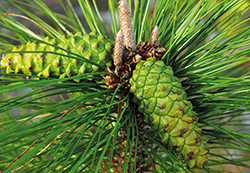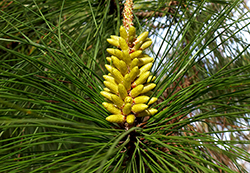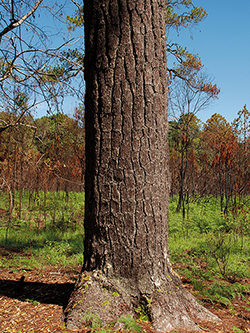e-Flora of Thailand
Volume 2 > Part 2 > Year 1972 > Page 193 > Pinaceae > Pinus
1. Pinus merkusii Jungh. & De Vriese wfo-0000482024
De Vriese, Pl. Nov. Ind. Bat. Or.: 5. t. 2. 1845; Kurz, Fl. Burm.: 499. 1877; Hook.f., Fl. Br. Ind 5: 652 1888; Hickel in Fl. i Gén. I.-C. 5: 1077. 1931; Raizada & Sahni, Indian Forest Rec. n.s. Bot. 5: 118. 1960; Suvatabandhu, J. natn. Res. Coun. Thailand 2: 61. 1961.
Accepted Name : This is currently accepted.
Description : Tree, with pyramidal crown when young, spreading or rounded when fully mature. Bark greyish brown to blackish brown, thick and deeply fissured. Leaves two in a fascicle, 15–25 cm long, convex, margins finely toothed. Cones solitary or in pairs, 5–8 cm long, ovoid or elongate-ovoid, erect, stalks± 1 cm long; scales woody, oblong, the exposed part rhomboid and furrowed. Seeds with a well-developed wing.
Thailand : Common in Northern, North-Eastern and Eastern provinces.
Distribution : India, Burma, Indochina, Sumatra (type), the Philippines.
Ecology : In the dry deciduous dipterocarp forests and lower montane forests, 600–1,300 m alt.
Vernacular : Son hang ma (สนหางหมา), son khao (สนเขา), son song bai (สนสองใบ), kia pluak dam (เกี๊ยะเปลือกดำ), kia pluak na (เกี๊ยะเปลือกหนา), chuang (จ๋วง), mai tai (ไม้ไต้), cho (โช), saron (สะรอล), paek (แปก), chiangsao (เชี้ยงเซา).
Uses: Wood used for building purposes, for wood pulp and general carpentry; resin and turpentine for medicine.
E-version notes : It is now referred to Pinus latteri Mason, Pinus merkusii is regarded as endemic to the Philippines and Sumatera; see Thomas, P. 2013. Pinus latteri. The IUCN Red List of Threatened Species 2013: e.T34190A2850102. http://dx.doi.org/10.2305/IUCN.UK.2013-1.RLTS.T34190A2850102.en.



